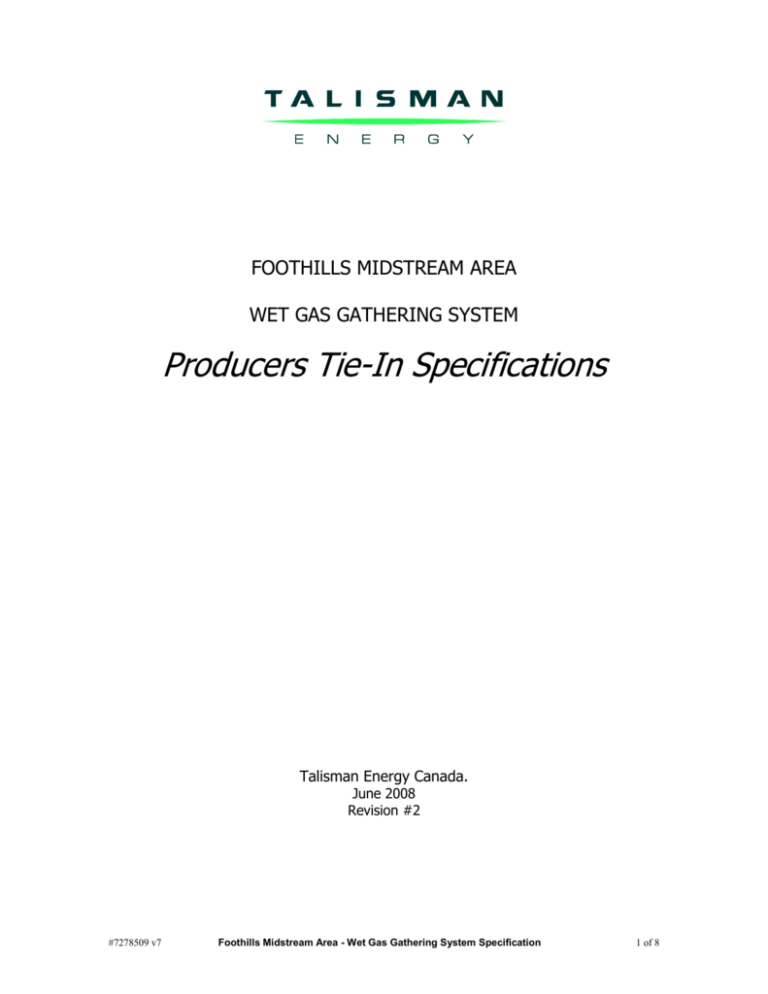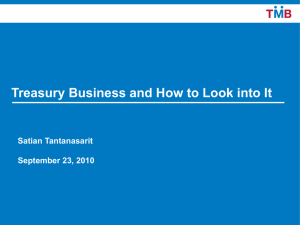- Talisman Energy, Inc.
advertisement

FOOTHILLS MIDSTREAM AREA
WET GAS GATHERING SYSTEM
Producers Tie-In Specifications
Talisman Energy Canada.
June 2008
Revision #2
#7278509 v7
Foothills Midstream Area - Wet Gas Gathering System Specification
1 of 8
PRODUCER TIE-IN SPECIFICATIONS
Foothills Midstream Area - Wet Gas Gathering System Specification
1.0 DESIGN AND COMMISSIONING REQUIREMENTS
Item
Description
Specification
Notes
1.1
Process Tie-in
Connection (Direct
Tie-in Only)
Approved riser / tee tie-in's are required for
any tie-in. If a Producer uses an existing tiein, the Producer must provide provisions for a
future tie-in (with approved valve).
TMO will install a manual block valve to
connect new pipelines into the gas gathering
system. The Producer lateral must allow for
inline inspection (‘pigging’). Hot taps are
NOT allowed on sour service pipelines.
Connections should the same size as the
Producer lateral.
Hot taps on sweet service pipelines are
permitted on a temporary basis and
require TMO approval.
1.2
Utility Tie-in
Connections (Direct
Tie-in Only)
If the Producer is taking fuel gas from the
same well as the production, the fuel gas tiein must be upstream of the receipt gas meter.
TMO will provide connections on existing
TMO facilities for fuel gas, instrument air /
gas, drain and flare, if available.
1.3
Piping / Mechanical
Requirements
(Direct Tie-in Only)
TMO requires the Producer to install: a
spectacle blind, a check valve, pipeline ESD
valve (remotely operable by TMO), cathodic
protection insulating kit, and
gas/hydrocarbons liquids sampling
connections with isolation valves,
immediately upstream of an acceptance
point.
The recommended CP Isolation kit is the
LineBacker kit. Corrpro is the CP
Company used by TMO.
1.4
Corrosion
Requirements
The continuous injection of a corrosion
inhibitor is required as specified by TMO.
Chemical injection must be ON when well
commissioning is complete and Producer has
permission to flow. All methanol used in the
Wet Gas Gathering System must be inhibited
as per TMO system requirements and must
obtain approval from the TMO Operations
Engineer. Prior to implementing a chemical
program, third party Producers must review
their proposed program with TMO’s
Corrosion Engineering Group and Operations
Engineer to obtain approval.
The rate of injection will be as specified
by the chemical manufacturer and TMO's
Corrosion Engineering Group. Sulphur
dispersants may be needed to control
sulphur deposition within the pipeline.
(Direct Tie-in Only)
A corrosion coupon shall be installed
upstream of the acceptance point isolation
valve such that it is positioned within regular
production flows and does not interfere with
pigging operations. High pressure
retrievable coupons are required as the
coupons can be retrieved without flow
disruption.
Caproco is the vendor TMO uses for
corrosion coupon installation, extraction
and analysis. Corrosion analysis data
should be sent to TMO Corrosion
Engineering Group. TMO Corrosion
Engineering Group will specify a
minimum for analysis frequency on a well
by well basis. The minimum coupon
analysis frequency is quarterly.
#7278509 v7
Foothills Midstream Area - Wet Gas Gathering System Specification
2 of 8
(Direct Tie-in Only)
Risers and tie-in connections to the TMO
system must not impede, hinder, or make
inline inspection tool ('smart pigs') unusable
within the TMO gathering system. TMO
Corrosion Engineering group reserves the
right to review all tie-in proposals to ensure
that system smart pig ability is not
compromised.
TMO utilizes 'smart pigs' for pipeline
inspection purposes. TMO requires 1
week notification before 3rd Parties
smart pig lines that directly connect to
our mainline assets. Results are to be
submitted to TMO for review.
(Direct Tie-in Only)
TMO, at its discretion, may require the
Producer to collect water/solids samples
recovered during pigging or normal
operation.
Such samples shall be made available
for TMO Corrosion Engineering Group
to inspect and the Producer to send out
for compositional analysis if requested
by TMO. Analysis results shall be
submitted to TMO Corrosion
Engineering Group for review.
1.5
Pipeline ESD Valve
(Direct Tie-in Only)
Fire safe to API 604 and equipped with: fail
close actuator, manual reset latch, solenoid
valve, open and close limit switches and
high/low pressure pilot. TMO Edson Control
Center to have control of the remote valve
operation and receives valve position status
signals.
In case of remote shutdown, Producer
will need to contact TMO Control Room
for remote reset.
1.6
Producer Facility
Design
TMO to review and approve the design of all
facilities connecting into the gas gathering
system prior to construction (for direct tie-ins)
and prior to start up (for indirect tie-ins).
The Producer is required to provide
TMO a complete Engineering Drawing
Package (stamped by a registered
APEGGA Professional Engineer)
applicable to the facilities for TMO’s
review and approval (Note: this can
take up to 14 days). The Producer is
also required to resubmit an "as-built"
drawings package stamped by a
Professional Engineer.
(Direct Tie-in Only)
Producer facilities may not encroach on or be
installed on the TMO right-of-way without the
appropriate agreements in place.
Producer is required to acquire the
Pipeline Installation License (PIL) for
the overlapping pipeline right-of-way
tie-in area(s).
(Direct Tie-in Only)
The maximum delivery pressure may not
exceed TMO pipeline specifications (MOP).
Contact the TMO Development
Engineer to acquire maximum delivery
pressure.
(Direct Tie-in Only)
No free liquids (hydrocarbon or water) are
allowed into the Wet Gas Gathering System.
Liquids must be removed at the well site.
Exceptions will be evaluated on a well by well
basis.
Refer to Gas Quality Specifications.
(Direct Tie-in Only)
TMO approved gas or liquid meters and
sampling points must be provided for each
product stream.
Refer to Section 2.0 Measurement
Requirements for additional details.
(Direct Tie-in Only)
Three phase separators incorporating
separate gas and liquid sampling analysis
are required. Producer must obtain TMO’s
approval for re-injection of hydrocarbon
liquids.
Hydrocarbon liquids (condensate) if reinjected, may only be injected
downstream of the gas meter.
#7278509 v7
Foothills Midstream Area - Wet Gas Gathering System Specification
3 of 8
1.7
(Direct Tie-in Only)
The Producer’s gas must not exceed TMO
pipeline H2S license. TMO will require a
H2S analyzer be installed at the acceptance
point.
(Direct Tie-in Only)
The Producer must incorporate into the
design of facilities a means to depressurize
and blow down the Producer’s pipeline.
Facility
Commissioning
The Producer is required to keep TMO
informed of the project schedule and
progress to prevent any delays in start-up
and commissioning of facilities.
(Direct Tie-in Only)
Producer representatives and contractors are
required to participate in safety orientation
prior to accessing any TMO sites or facilities.
Notification shall be given 72 hours in
advance of any construction activities. Work
on TMO Lease or R.O.W. must be
supervised by TMO Representatives.
(Direct Tie-in Only)
A TMO representative must witness the
calibration, configuring and adjusting of
primary, secondary and tertiary
measurement equipment at the time of site
commissioning and prior to TMO issuance of
a 'turn-on' approval. The remote activation
via SCADA of devices configured to provide
remote control must be tested and their
functioning verified. Status monitoring
functionality must also be verified and tested.
Documentation in support of calibrations
must be provided to TMO.
Refer to Gas Quality Specifications.
All Producer representatives and
contractors shall have a daily permit
and all necessary regulatory permits
prior to conducting any work on TMO
sites. Arrangements are to be made
with Production Foreman/Coordinator.
Daily permits may be obtained from the
Production Foreman/Coordinator.
Provisions shall be made to ensure NO
pipeline hydro test fluids or well completion
fluids enter into the TMO pipeline. TMO
must review the Producer’s plan for ensuring
these fluids do not enter the pipeline.
1.8
Costs
#7278509 v7
The Producer is responsible for all costs
(material and labour), including costs
incurred by TMO for work required to meet
these tie-in specifications.
Cost recovery will be a lump sum
payment. Any future site conversion
costs to meet receipt point
requirements will be the Producer’s
responsibility.
Foothills Midstream Area - Wet Gas Gathering System Specification
4 of 8
PRODUCER TIE-IN SPECIFICATIONS
Foothills Midstream Area - Wet Gas Gathering System Specification
2.0 MEASUREMENT REQUIREMENTS
Item
Description
Specification
Notes
2.1
Gas Metering
Requirements
TMO will require scheduled meter
inspections and recommends using orifice
with senior fittings to facilitate these
inspections. Where multi run flow metering is
utilized, separate temperature, pressure and
flow transmitters for each run (complete with
local indicators) is required. TMO must
approve all meters (orifice or non-orifice
meters) incorporated into the facilities design.
Metering designs should be submitted to
TMO for approval before any facilities
detailed engineering design is initiated.
Primary meters of a type other than
orifice may be utilized by permission of
TMO.
Orifice meter design (and instances
where flow conditioners are utilized) per
ERCB Directive 017 'Measurement
Requirements for Upstream Oil and Gas
Operations' specifying which version of
AGA Report #3 Orifice Metering of
Natural Gas is applicable.
2.2
Liquid Metering
Requirements
The meters must be equipped with electronic
pickups for RTU integration, uploading to
SCADA and incorporate a local totalizer.
TMO must approve all liquid meters and
related secondary and tertiary devices
incorporated into the facilities design.
For receipt points, meter factors must be
updated twice yearly or after repairs or
change outs. Proving will be conducted by
TMO.
Metering designs should be submitted to
TMO for approval before any facilities
detailed engineering design is initiated.
ERCB, AGA, API and industry approved
turbine or positive displacement liquid
meters with temperature and pressure
correction. Located upstream of a snap
acting liquid level valves. Proving taps
installed between the meter and the snap
acting liquid level valve complete with
isolating double block and bleed or cavity
vented valves. Strainer/filter upstream of
the meter.
2.3
Fuel Gas Metering
Requirements
Fuel gas meters compliant with ERCB, API
and industry standards must be incorporated
into the facilities design upstream of the
receipt point meter. Meters upstream of the
receipt point meter need not be approved by
TMO. If however, TMO gas is provided to
the Producer as fuel gas, TMO must approve
all gas meters and related secondary and
tertiary devices expected to be incorporated
into the facilities design.
Metering designs should be submitted to
TMO for approval before any facilities
detailed engineering design is initiated.
Fuel meters measuring TMO gas cannot
exceed a maximum measurement
uncertainty of 3%. A six year minimum
calibration or verification frequency is
required. Fuel gas volumes greater than
0.5 103 m3/day must be measured, less
than 0.5 103 m3/day requires an
engineering estimate. For PD meters,
pressure and temperature shall be
measured from the upstream side of the
meter within 20 pipe diameters.
2.4
General Sampling
Requirements
Dedicated sample probes must be installed
upstream of gas meters and upstream of
liquid meters. Gas must be sampled through
the top of the pipe and liquid sampling
through the side of the pipe. Sample points
must be uniquely, clearly marked and
identified with non-destructible tags.
The presence of H2S requires an on-site
Tutwiler test or appropriate means for
measurement of lower H2S
concentrations.
#7278509 v7
Foothills Midstream Area - Wet Gas Gathering System Specification
5 of 8
A gas analysis from an analogy or
completion results is required at the time of
tie-in application submission, followed by a
flowing gas and liquid analysis to be taken 14
days after initial start-up and results
submitted within 30 days after sampling.
Sampling
Requirements
Single zone well: Annual gas and liquid
analysis required.
Commingled multi zone well: TMO requires
monthly gas and liquid spot sampling for the
first six months of production. An evaluation
of each of the first six months of spot
analysis received by TMO will be performed
to determine the extent of compositional
fluctuation. If it is determined that the
resulting gas and liquid analysis is nonfluctuating then yearly spot sampling may be
undertaken thereafter. If however, the
resulting analysis reveals a fluctuating
composition, then the installation of a
continuous (monthly), proportional to flow
gas samplers is required at the receipt point.
Invalid sample results derived from
continuous sampling would require near real
time gas chromatographs be installed.
Multi zone or multi wells across a receipt
point (facility meter): Require the
installation of continuous, proportional to flow
gas and liquid samplers. Sample cylinders
are required to be analyzed at monthly
intervals.
Analysis Using Gas
Samplers
The Producer shall be responsible for the
collecting and delivery of monthly samples to
a certified laboratory for analysis (if
applicable).
TMO requires the Producer to obtain the
gas analysis at specific times of the
month to accommodate production
accounting business processes. The
schedule should be confirmed with the
TMO Operations Engineer.
ProTrend
The results of all analysis shall be made
available to TMO via ProTrend.
After review and approval from TMO, the
gas analysis results shall be deemed to
be the typical gas analysis for the
particular receipt point from the date
identified to TMO by the Producer and
shall be used for measurement and
allocation purposes for the receipt point.
TMO reserves the right to reject any
invalid gas analysis and ask Producer to
take another gas sample for analysis.
Costs
The Producer is responsible for all costs
(material and labour), including costs
incurred by TMO for work required to meet
these tie-in specifications.
Cost recovery will be a lump sum
payment. Any future site conversion
costs to meet receipt point requirements
will be the Producer’s responsibility.
2.5
2.6
2.7
2.8
Water samples are also recommended
by TMO Corrosion Engineering Group.
Gas and liquid analysis shall be
standardized to C7+ and C30+,
respectively, for all samples.
#7278509 v7
Foothills Midstream Area - Wet Gas Gathering System Specification
6 of 8
PRODUCER TIE-IN SPECIFICATIONS
Foothills Midstream Area - Wet Gas Gathering System Specification
3.0 DATA ACQUISITION REQUIREMENTS
Item
Description
Specification
Notes
3.1
Data Requirements
A technical solution must meet the following
requirements for standard data set:
equivalent latency, accuracy, completeness
of data. Final approval of solutions is at the
sole discretion of TMO. TMO requires the
ability to download or export data in a .csv
file format anytime.
Direct Tie-in:
Minimally, both real time and archived data is
required as per Directive 017 Daily Report
and Meter Report requirement. In addition,
the following data is also required, both real
time and archived:
-dew point analyzer reading,
- H2S concentration,
-emergency shutdown valve (ESD)
Indirect Tie-in:
Producer wells that are not delivering gas
directly into the system on a daily basis need
to provide daily cumulative volume.
Confirm data lists with TMO. TMO
reserves the right to collect additional
data as required. Prior to start-up at the
time of commissioning the RTU must be
validated using an approved flow
calculation application applying ERCB
Directive 17 4.3.3.2 test cases.
3.2
Fixed Frequency
Radio (Direct Tie-in
Only)
The Producer must confirm radio frequency
and adequate communication path with TMO
to ensure there is two-way communication.
TMO will not allow tower access to third
parties.
3.3
Remote Terminal
Units and
Transmitters
Requirements
(Direct Tie-in Only)
TMO has standardized on the Bristol 'Control
Wave Micro' RTU utilizing Bristol 3820
transmitters or the Bristol model 'XFC XP'
with three in one transmitters internal to the
unit incorporating standardized programs and
algorithms approved by TMO. EFM or RTU
devices must provide the necessary control
enablement, status monitoring by and data
uploading to the TMO owned and operated
SCADA system.
Transmitters must be of the "SMART" type
and provide output signal (either analog or
digital), continuous measurement of fluid
temperature, static pressure, and remote reranging. It must also provide configuration
and diagnostics using either a dedicated
hand held or laptop computer with
appropriate software and a local indication
with remote configuration lock out capability.
All field instruments must be capable of
operating between -40°C to 60°C and
incorporate in their design a means of
adjusting the calibration to compensate
for a shift in ambient temperature.
Approved hardware (processor type, I/O
modules, etc) shall be supplied by the
Producer. This hardware shall be
installed consistent with the standard
RTU configuration (Refer to 3.3 RTU
Programming).
TMO strongly recommends any RTU
installed upstream of a receipt point be in
accordance with the attached
specifications to allow for future receipt
point movement.
#7278509 v7
Foothills Midstream Area - Wet Gas Gathering System Specification
7 of 8
3.4
RTU Programming
(Direct Tie-in Only)
Producer shall use the TMO provided
standard RTU configuration. Producer is
responsible for RTU configuration, loading,
RTU commissioning, RTU commissioning to
the SCADA Host, and shall communicate any
and all changes to the standard RTU
configuration to TMO. The Producer is
responsible for providing TMO a complete
and updated Tag List for all tags defined in
the RTU configuration. This information shall
be provided to TMO in reasonable time for
SCADA Host configuration prior to
commissioning and start-up.
3.5
Bristol BSAP.
3.6
Protocol (Direct Tiein Only)
Polling
Requirements
(Direct Tie-in Only)
3.7
Time Sync
All RTUs will be time synced to the TMO
SCADA Master using MST. Time sync will
be performed via the slave port of the
Producer owned RTU.
3.8
SCADA Host
Configuration
(Direct Tie-in Only)
TMO will develop the SCADA host
configuration based on the standard RTU
configuration and Producer supplied P&IDs
and/or shutdown key.
3.9
Power
Requirements
(Direct Tie-in Only)
Backup power source for 24 hours. Voltage
monitoring signal will be provided to allow for
a LOW Voltage alarm to be generated and
communicated to the SCADA Host.
TMO recommends separate power
supply for the radio and separate power
supply for RTU.
3.10
Remote Control
Commands (Direct
Tie-in Only)
TMO requires SCADA remote shut-in and
SCADA open (reset) control for acceptance
point ESD including fuel gas (where
applicable) and water dew point analyzer
bypass. The Producer shall not reset an
electronic ESD command that has been
issued by TMO.
TMO shall have the ability to ESD any
production into the TMO gathering
system from SCADA. This includes
liquids or gas where applicable. In the
case where it is agreed that a well site
ESD is to be used as the tie-in ESD, the
Producer must retain the ability to
independently control the well head ESD.
The manual ESD reset latch still remains
the final control element.
3.11
RTU Atmospheric
Pressure
Configuration
(Direct Tie-in Only)
TMO requires atmospheric pressure be
configured in the RTU.
The atmospheric pressure is based on
actual elevation utilizing the following
formulas:
P (kPa) = 101.560 - (0.0113 x elevation),
where elevation is in meters.
3.12
Costs
The Producer is responsible for all costs
(material and labour), including costs
incurred by TMO for work required to meet
these tie-in specifications.
Cost recovery will be a lump sum
payment. Any future site conversion
costs to meet receipt point requirements
will be the Producer’s responsibility.
#7278509 v7
Configuration of the SCADA Host will be
based on tag signals/addresses as
configured in the standard RTU
configuration load. TMO will execute the
SCADA host configuration.
Also refer to section 3.7. All RTU/EFM
devices must comply with API Chapter
21, Flow Measurement Using Electronic
Metering Systems, AGA and ERCB
Directive 017 Measurement
Requirements for Upstream Oil and Gas
Operations.
TMO SCADA as master. Producer RTU
shall be polled as a slave device by TMO
SCADA. The RTU slave address will be
assigned by TMO for the RTU.
All clocks set to Mountain Standard Time
(M.S.T.). Contract time set at 8 am
(M.S.T). Daylight savings must be
disabled.
Foothills Midstream Area - Wet Gas Gathering System Specification
8 of 8






